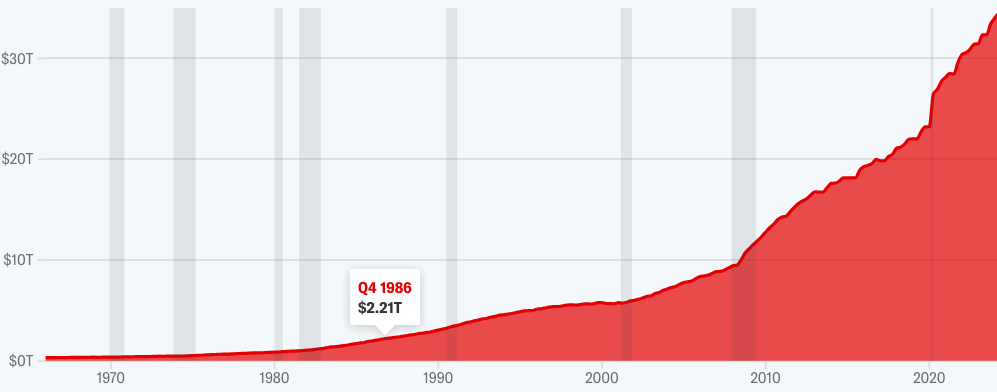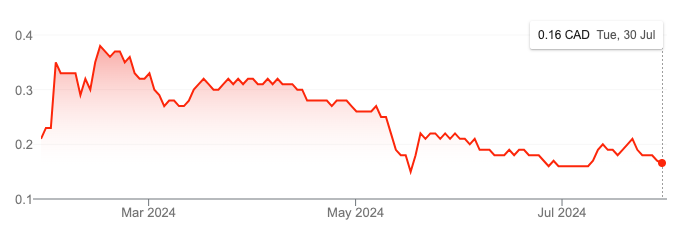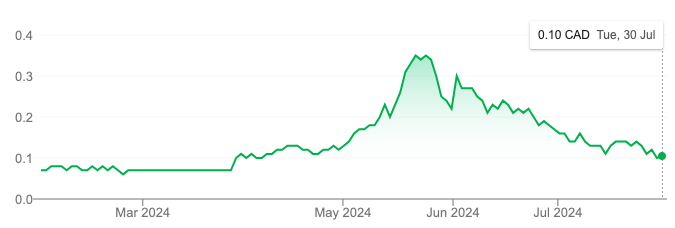- The U.S. national debt has reached $35 trillion, increasing by nearly $5 billion daily in 2025.
- The debt now equals 120% of GDP, with projections to rise to 166% by 2054.
- As concerns over national debt grow, experts suggest investing in commodities as a hedge against inflation.
The U.S. national debt has surpassed the significant milestone of $35 trillion, marking a notable point in the country’s financial history. Since January, the debt has increased by $1 trillion, growing at a rate of nearly $5 billion per day in 2025. This latest development was officially recorded last Friday, when the Treasury Department’s daily tabulation showed a gross debt level of $35.001278 trillion. Notable figures, such as Tesla CEO Elon Musk, have expressed concern, with Musk describing the situation as “crazy” in a social media post.
Historical Debt Growth and Political Response
The debt has surged by over 75% during the Trump and Biden administrations, yet it remains a back-burner issue in the 2024 campaign season. Deficit hawks warn that the debt problem is often overshadowed by proposals that could exacerbate the situation. Maya MacGuineas, president of the Committee for a Responsible Federal Budget, criticized the unchecked borrowing, labeling it as “reckless and unyielding.” Despite some efforts by policymakers, the debt now stands at 120% of GDP, a level not seen since the end of World War II. The Congressional Budget Office forecasts that high interest costs could push the debt to 166% of GDP by 2054.

Reactions and Future Concerns
A few lawmakers, including retiring Senator Mitt Romney and Senator Cynthia Lummis, acknowledged the $35 trillion milestone. Lummis, following her appearance at a Bitcoin 2024 conference, proposed a “strategic bitcoin reserve” to help manage the debt, suggesting the government acquire 1 million bitcoins using existing funds. However, this idea faces significant challenges in Congress and depends on the cryptocurrency’s value increasing faster than borrowing costs.
A Looming Tax Debate
Washington has made some attempts to manage the debt, such as the 2023 Fiscal Responsibility Act, which included spending caps. However, a significant tax debate looms in 2025, with major provisions of the 2017 Trump tax cuts set to expire. This situation could result in an effective tax hike if not addressed, potentially adding trillions more to the debt. Former President Trump has promised to extend these tax cuts, which could add between $4 trillion and $5 trillion to the debt if not offset. The Democratic plan, supported by Biden and Vice President Harris, proposes extending the cuts only for those earning under $400,000, potentially costing over $2 trillion if not offset by other means.

Protecting Wealth Through Commodities Investments
Given the increasing national debt and potential inflationary pressures, many financial experts highlight the importance of safeguarding wealth by investing in commodities. Commodities, such as gold and silver, have historically served as a hedge against inflation and currency devaluation. They provide a stable store of value and help investors preserve purchasing power during economic uncertainties. Moreover, commodities can diversify an investment portfolio, reducing overall risk.
Investing in Element 79
For those interested in the commodities sector, Element 79 presents an intriguing investment opportunity. According to recent updates, Element 79 has introduced several initiatives aimed at expanding its market presence and increasing shareholder value. The company focuses on exploring and developing mineral resources, particularly gold, which remains a popular choice for diversifying portfolios. Element 79’s initiatives include new mining projects and enhancing production capabilities, positioning it as a potential high-yield investment.

World Copper’s Recent Performance
Another compelling investment in the commodities sector is World Copper, which recently saw a notable increase in its stock price. World Copper’s stock surged by 14%, reflecting positive market sentiment and a promising outlook. Copper is essential in industries like electronics, construction, and renewable energy, making it a valuable asset in the global economy. As demand for copper grows, driven by technological advancements and green energy initiatives, World Copper’s strategic expansions position it well for significant growth, offering potential returns for investors in the commodities market.

Conclusion
The U.S. national debt reaching $35 trillion is a significant milestone that highlights the country’s growing fiscal challenges. With the debt now representing 120% of GDP and projections of further increases, the issue demands urgent attention from policymakers. As the nation grapples with this financial burden, investors are encouraged to consider commodities as a hedge against inflation and economic instability. Companies like Element 79 and World Copper offer promising opportunities in the commodities sector, providing potential growth and a safeguard for wealth. The future trajectory of the national debt will continue to be a critical issue, shaping economic policies and investment strategies alike.
Marc has been involved in the Stock Market Media Industry for the last +5 years. After obtaining a college degree in engineering in France, he moved to Canada, where he created Money,eh?, a personal finance website.

